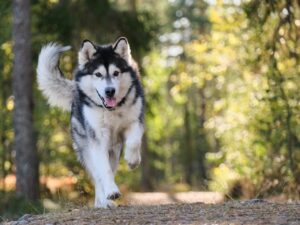If you’ve ever had your dog enthusiastically jump on you or your guests, you’re not alone. Many dog owners face this common but frustrating behavior of how to stop your dog from jumping. While your dog may think it’s a playful greeting, jumping can be overwhelming, lead to accidents, and even scare some visitors. Fortunately, with the right approach on how to stop your dog from jumping, you can teach your dog to greet people politely.
This guide will explore why dogs jump, the mistakes owners often make, and provide actionable steps to curb this behavior effectively. By the end of this article, you’ll have the tools and strategies needed to stop your dog from jumping and create positive, calm greetings instead.
Understanding how to stop your dog from jumping is vital for a harmonious relationship between you and your pet.
Table of Contents
How to Stop Your Dog from Jumping
When learning how to stop your dog from jumping, it’s essential to understand the context of this behavior.
1. How to Stop Your Dog from Jumping: Seeking Attention
To effectively understand how to stop your dog from jumping, realize that dogs are social animals who crave interaction.
2. How to Stop Your Dog from Jumping: Excitement
Section 1: Why Do Dogs Jump on People?
Understanding why your dog jumps is the first step in addressing the behavior. Dogs aren’t trying to misbehave; they’re simply reacting instinctively or based on learned behaviors. Here are some common reasons:
When considering how to stop your dog from jumping due to excitement, think about their energy levels.
3. How to Stop Your Dog from Jumping: Learned Behavior
To know how to stop your dog from jumping, recognize that learned behaviors can be modified.
Understanding how to stop your dog from jumping requires identifying the root causes behind the behavior.
1. Seeking Attention
Learning how to stop your dog from jumping involves addressing persistent behaviors.
Let’s delve into how to stop your dog from jumping by recognizing common pitfalls.
Dogs are social animals and crave interaction with their humans. Jumping is often their way of demanding attention, whether it’s petting, talking, or even eye contact. Even negative attention, such as scolding, can reinforce this behavior.
2. Excitement
When learning how to stop your dog from jumping, the approach matters.
When dogs are excited, they often struggle with impulse control. Jumping is a way to release pent-up energy and express their joy when they see you or a guest.
3. Learned Behavior
If you’ve ever petted your dog or spoken to them when they jumped, you’ve likely reinforced the habit. Dogs quickly learn that jumping results in attention, even if it’s unintentional.
4. Greeting Behavior
Dogs naturally greet each other face-to-face. Since humans are taller, dogs jump to reach our faces. It’s their instinctive way of saying hello.
By identifying why your dog jumps, you can tailor your training approach to address the root cause of the behavior.
Section 2: Common Mistakes Owners Make
Before diving into solutions, it’s important to understand the mistakes that can unintentionally encourage jumping. Avoiding these pitfalls will make your training efforts much more effective.
1. Reacting with Excitement
When your dog jumps, it’s tempting to respond with laughter, petting, or even playful pushing. While you might think you’re discouraging the behavior, your dog interprets this as positive attention.
To effectively know how to stop your dog from jumping, removing attention is crucial.
2. Pushing the Dog Down
The key to how to stop your dog from jumping is consistency in training.
Many owners instinctively push their dogs off when they jump. However, dogs may see this as a game or as physical engagement, reinforcing the behavior instead of discouraging it.
3. Rewarding the Behavior
Giving treats, affection, or eye contact while your dog is jumping sends the message that jumping gets them what they want. Even scolding can serve as a reward if your dog is simply seeking attention.
Avoiding these mistakes lays the foundation for effective behavior modification.
When discussing how to stop your dog from jumping, reinforcement strategies are vital.
Section 3: Step-by-Step Guide to Stop Jumping
Now that you understand the causes and common mistakes, let’s move on to actionable steps to stop your dog from jumping. Consistency and patience are key to success.
By practicing these methods on how to stop your dog from jumping, you ensure effective results.
1. Teach an Alternative Greeting Behavior
One of the most effective ways to stop jumping is to teach your dog an alternative behavior, such as sitting. Here’s how:
- Start with Basic Training: Begin by reinforcing the “sit” command in a distraction-free environment. Use treats and praise to reward your dog when they sit on command.
- Apply It During Greetings: When your dog approaches you or a guest, ask them to sit before they can receive attention. Only reward them with petting or treats once they are seated.
- Practice Often: Consistently reinforce the behavior until sitting becomes your dog’s default response during greetings.
In summary, knowing how to stop your dog from jumping involves clear communication and understanding.
2. Ignore Jumping Behavior
Dogs thrive on attention, so removing attention when they jump can be a powerful training tool:
- Turn Away: When your dog jumps, turn your back to them and avoid eye contact or speaking.
- Stay Calm: Ignore your dog until all four paws are on the ground. Once they calm down, reward them with gentle attention.
- Be Consistent: Everyone in the household must follow this rule to prevent mixed signals.
3. Consistency Is Key
Consistency is crucial for success. Here’s how to maintain it:
- Train All Family Members: Ensure that everyone in the household follows the same rules when the dog jumps. Mixed messages can confuse your dog and slow progress.
- Prepare Guests: Inform visitors about your training efforts and ask them not to reward jumping behavior. Provide clear instructions on how to interact with your dog.
4. Use Positive Reinforcement
Positive reinforcement is one of the most effective ways to shape your dog’s behavior:
- Reward Desired Behavior: Give treats, praise, or affection when your dog greets people calmly.
- Phase Out Treats: Gradually reduce the use of treats over time and rely on verbal praise or affection as rewards.
5. Redirect Energy
Learning how to stop your dog from jumping takes patience and practice. Every dog learns differently, but with time and consistent effort, you’ll see results.
Sometimes, jumping is a result of excess energy. Addressing this can help reduce the behavior:
- Provide Toys or Chews: Offer a toy or chew when your dog is overly excited. This gives them an outlet for their energy.
- Increase Exercise: Ensure your dog gets enough physical and mental stimulation through daily walks, playtime, and training sessions.
6. Train in Controlled Situations
Practicing in controlled environments helps your dog succeed:
- Start Small: Begin with familiar people in calm settings before introducing new guests.
- Use Leash Training: During training sessions, keep your dog on a leash to prevent jumping and guide their behavior.
- Gradually Increase Challenges: Once your dog masters calm greetings at home, practice in more distracting environments, like parks or during walks.
Section 4: Addressing Persistent Jumping Behavior
While the steps above work for most dogs, some may require additional support. Here’s how to address persistent jumping:
1. Seek Professional Training
If your dog continues to jump despite your efforts, consider working with a certified dog trainer. They can provide personalized guidance and help address underlying issues.
2. Rule Out Health Issues
Occasionally, hyperactive or persistent jumping may be linked to health problems, such as anxiety or hormonal imbalances. Consult your veterinarian to rule out any medical concerns.
3. Practice Patience and Persistence
Behavior modification takes time. Be patient with your dog and celebrate small victories along the way. Remember that consistency and positive reinforcement are the keys to lasting change.
Conclusion
Jumping is a common behavior in dogs, but understanding how to stop your dog from jumping can lead to effective management. By recognizing the reasons why dogs jump, avoiding mistakes, and implementing consistent training techniques, you can teach your dog to greet people calmly and politely.
Remember, patience and persistence are essential. Every dog learns at their own pace, but with time and effort, you’ll see progress. If you have any questions or want to share your experiences, comment below. For more tips on dog training and behavior, explore other posts on WoofyTips.com. Together, we can create a happier, well-behaved pup!
Quit Jumping Up




